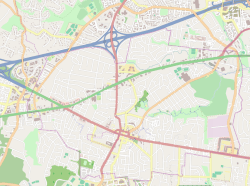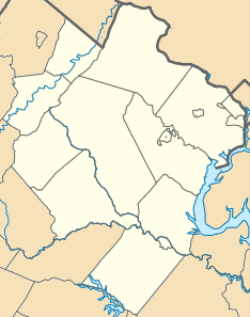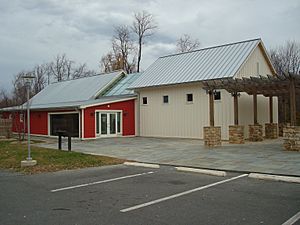Historic Blenheim facts for kids
Quick facts for kids |
|
|
Historic Blenheim
|
|

Blenheim (Willcoxon Farm)
|
|
| Location | 3610 Old Lee Hwy Fairfax, Virginia |
|---|---|
| Built | c. 1859 |
| NRHP reference No. | 01000152 |
Historic Blenheim is an old brick farmhouse in City of Fairfax, Virginia. It was built around 1859 in a style called Greek Revival. During the American Civil War, many Union soldiers camped near the house. They even used it as a backup hospital. Because of this, over 115 soldiers drew pictures and wrote messages on the walls. You can find these writings on the first and second floors, and in the attic. Blenheim became a nationally recognized historic place in 2001.
Contents
The Willcoxon Family and Blenheim's Beginnings
The land where Historic Blenheim stands today once belonged to Captain Rezin Samuel Willcoxon. He was a soldier in the War of 1812. In the early 1800s, he bought a lot of land in what is now Fairfax, Virginia. At one point, he owned over a thousand acres!
Rezin Willcoxon farmed about 400 acres of his land. He grew crops like wheat and corn. In 1854, his son, Albert T. Willcoxon, bought a large part of the farm. Albert likely took over running the family farm.
A New House for the Family
In 1855, a fire destroyed the original farmhouse. The house you see today was built to replace it. It might have been built on the old house's foundation.
After Rezin passed away in 1855, his land was divided among his children. Albert kept the Willcoxon house and much of the property. In 1858, Albert married Mary Hunter Eskridge. They continued to run the farm. They had help from several enslaved people. We know the names of three of them: Charles, Hanson, and Maria.
Blenheim During the Civil War
Albert and Mary Willcoxon supported the Confederate side. They sold supplies like beef and horses to Confederate soldiers. However, by October 1862, the Union Army controlled Fairfax. The war caused a lot of damage to the area.
At some point in 1862, Albert, Mary, and their two children left the farm. They may have stayed with Mary's family in Leesburg until the war ended.
Fairfax's Role in the War
Fairfax was very important because it was close to Washington, D.C., the nation's capital. Blenheim was right in the middle of the wartime action.
Early in the war, Confederate soldiers guarded the town. In June 1861, a Union cavalry unit attacked them. The Confederates fought back and kept control of the town for a while. Later, in July 1861, the Union Army took over Fairfax. Control of the city changed many times. By March 1863, it was firmly a Union stronghold.
Soldiers' Messages on the Walls
Because Blenheim was empty and in a key location, Union soldiers eventually moved in. The house was likely used as a hospital for wounded soldiers.
These soldiers didn't just stay there; they left their mark! They wrote and drew on the walls of the first floor, second floor, and attic. There are over 100 names, army units, dates, poems, and drawings. At least 23 different military groups are represented. Some of the earliest writings are from March 1862.
Some of the soldiers who wrote on Blenheim's walls later died in famous battles. These include battles like Second Manassas and Gettysburg. Others might have been wounded nearby or gotten sick in army camps.
Since 1997, researchers have been studying these wall writings. They figure out the names and army units. Then, they use old records to learn the stories of these soldiers.
Blenheim After the War
When Albert Willcoxon passed away in 1889, his land was divided between his children, Harry and Bessie. Harry continued to run the farm. It became well-known for its dairy products. People said he produced the best milk in the area.
The name 'Blenheim' was first used for the farm in 1903. However, many still called it 'Willcoxon Place' for a long time.
Changes Over Time
By the 1930s, a tenant farmer was running the farm. In 1939, Harry gave Blenheim to his niece, Marguerite (Daisy). Farm work continued through the 1950s. At that time, the farm had many buildings, including barns, sheds, and a dairy house.
By 1953, the Willcoxon family began selling off parts of the farm for new buildings. The original large property shrank to just twelve acres. In 1962, Marguerite's daughter, Barbara Duras, moved into the house with her husband. The City of Fairfax bought the historic site in 1999. A family cemetery, where four generations of Willcoxons are buried, is next to the house.
Blenheim Today
The Willcoxon family never covered up the soldiers' writings in the attic. After the war, the attic was mostly used for storage. Over the years, many layers of wallpaper were added to the first and second floors. But the drawings on the walls were never destroyed. Today, the wallpaper has been removed, and you can see the inscriptions clearly.
In 2001, Historic Blenheim was added to the National Register of Historic Places. Next to the house is the Civil War Interpretive Center, which opened in 2008. This center helps visitors learn more about the site.
Inside the center, there's a gallery with displays about the Union soldiers who stayed at Blenheim. It shows how their stories fit into the larger American Civil War. Since the second floor and attic of the house are not open to the public, the center has a special replica. It's an exact copy of two-thirds of Blenheim's attic, with life-sized images of the wall writings. The center also has a room for school groups and special programs.







